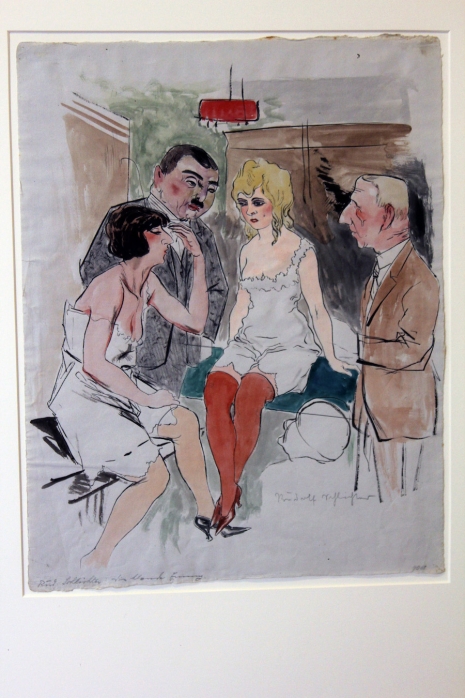
A surrealist-style painting by German artist, Rudolf Schlichter.
At the age of 26, while he had been pursuing his studies at the Art Academy of Kunstakademie in Karlsruhe, German artist Rudolf Schlichter was drafted into the army. Following a successful hunger strike, Schlichter was dismissed from his duties and returned to the bustling, forward-thinking town of Karlsruhe. Schlichter didn’t stick around for long and soon set off for Berlin where he fell in with the Dada scene and became a communist.
Schlichter made a successful living in Berlin from his illustrations. He transitioned from Dada to the “Neue Saclichkeit” movement (or “New Objectivity”) that used realism to express skepticism related to current events. He quickly became one of the most influential and critically important contributors to this quasi-Expressionism. Within New Objectivity there were two additional artistic courses: The “Verists” were known for using portraiture as a vehicle for their hostility toward authority figures, affluence and the oppression of society. The works of the great Otto Dix played a large role in this sub-component of New Objectivity. The other was commonly referred to as “Magic Realists” who were in opposition to the German style of Expressionism. Probably the most notable Magic Realism artist was Georg Schrimpf whose work was a crucial part of New Objectivity. Now that we’ve got your mini subversive art lesson out of the way, here’s a bit more on Rudolf Schlichter whose work, though not initially, was reviled by the Nazis.
While Schlichter’s body of work is as vast as it is diverse, there were many recurrent points of interest and themes, especially erotic ones, in his paintings and illustrations. Often his subjects were comprised of various bohemian movers and shakers and other residents who were part of the vibrant counterculture of the streets of Berlin where he spent much of his time. In 1923 Schlichter provided 60 illustrations for an edition of Oscar Wilde’s The Ballad of Reading Gaol. At the end of the 1920s, Schlichter returned to being a practicing Catholic and would end up doing illustrations for various religious publications put out by the church including a youth-oriented magazine called Jungle Front. The illustrations in the magazine often cast a disparaging light on the politics of Adolf Hitler. Coincidently at the time of its publication, Schlichter also belonged to the exclusively German art organization run by the Third Reich, “Reichskammer der bildenden Künste” or the “Reich Chamber of Fine Arts” headed up by propagandist extraordinaire Joseph Goebbels. And as you might imagine the jab didn’t go unnoticed and Schlichter was promptly ousted. His work was removed from galleries and destroyed and Schlichter’s name was added to the “degenerate art” list kept by the Nazis. Which in my mind is always the right kind of list to be on, in any time period.
Though he would pass away at the age of 65, a little more than a decade prior to his death Schlichter produced many remarkable pieces of surrealistic style paintings. Which would lead to the artist being dubbed “the German Salvador Dali.” I’ve included a few of Schlichter’s surrealist works as well as a nice sampling of his erotica below. Which means much of what follows is NSFW.


“Blonde Enemy” 1922.

“Dada Roof Studio.”
More after the jump…





